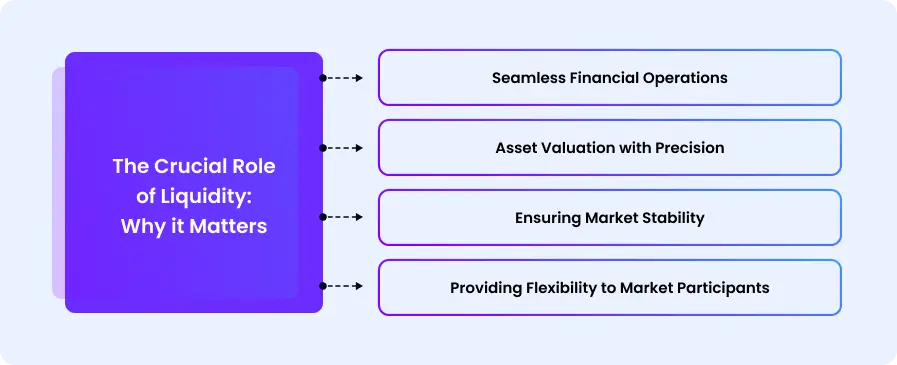Deep Dive: Liquidity in Crypto and its Importance in Financial Markets
In the vast realm of financial markets, the concept of liquidity is undeniably a cornerstone. From traditional assets such as stocks and real estate to the burgeoning world of cryptocurrencies, understanding liquidity's multifaceted role is pivotal for both investors and market analysts. This article provides an extensive exploration of liquidity, emphasizing its significance in the crypto landscape.
The Essence of Liquidity: An Introductory Perspective
At its core, liquidity in crypto, as well as in other financial markets, pertains to the ease with which an asset—be it a digital currency or a traditional security—can be converted into cash. This also encompasses how quickly an asset can be bought or sold without causing a significant ripple in its price. In more tangible terms, the liquidity of an asset can dictate the rapidity and efficiency of buy and sell orders, offering a more transparent and predictable landscape for market participants.
For a more relatable illustration, imagine owning a piece of rare art and a gold bar. While both items are valuable, they differ significantly in terms of liquidity. The gold bar, being a universally recognized valuable commodity, is inherently more liquid, with a plethora of interested buyers readily available. In contrast, the rare artwork might require a specific niche of collectors, and finding the right buyer could be a time-consuming endeavor. Extend this analogy to the world of assets: real estate properties might not be as liquid as popular cryptocurrencies like Bitcoin, which boasts substantial trading volume and interest.
The Crucial Role of Liquidity: Why it Matters
The fluidity offered by liquidity is foundational to the stable functioning of financial ecosystems. Below are key reasons elucidating its significance:
Seamless Financial Operations: Whether you're operating within traditional financial markets or the crypto universe, high liquidity ensures a smooth flow of transactions. This fluidity is vital for facilitating the conversion of assets into cash or enabling swift trade execution.
Asset Valuation with Precision: A market replete with liquidity offers continuous insights into asset prices, assisting in achieving a more accurate valuation. The uninterrupted interaction of buyers and sellers, particularly in the bustling cryptocurrency market, guarantees that assets are procured and liquidated at justifiable price points.
Ensuring Market Stability: Robust liquidity acts as a buffer, safeguarding against extreme price swings resulting from substantial buy or sell orders. Such stability is a bulwark against potential market manipulations, fostering a more transparent and equitable trading environment.
Providing Flexibility to Market Participants: Highly liquid assets, whether in traditional or crypto markets, grant investors and traders the leeway to modify their asset positions, adapting to changing market conditions or personal financial requirements.

Crypto Liquidity Explained
In the world of cryptocurrencies, liquidity delineates the simplicity with which a digital asset can be procured or liquidated without triggering drastic price swings. A cryptocurrency's liquidity level provides insights into the availability of potential buyers and sellers, as well as the speed at which trades can be executed at reasonable prices.
Digital currencies with significant trading volumes, like Bitcoin or Ethereum, are indicative of an expansive and active user base. This bustling activity ensures that these digital assets can be easily transacted with minimal impacts on their prevailing market prices.
However, understanding crypto liquidity is incomplete without considering market depth and the bid-ask spread. Market depth offers insights into the pool of buy and sell orders at different price points. Meanwhile, the bid-ask spread represents the difference between the maximum price a buyer is prepared to pay and the minimum price a seller is willing to accept. Narrow spreads typically signal a more liquid market.
Demystifying Concepts Central to Crypto Liquidity
Liquidity Pools: These pools can be envisaged as vast reservoirs that aid in facilitating decentralized trades without relying on intermediaries. In decentralized exchanges (DEXs), liquidity pools are integral, ensuring the smooth operation of these platforms.
Crypto Liquidity Providers: These entities or individuals infuse their cryptocurrency assets into liquidity pools. Their contributions play an indispensable role in ensuring that digital assets can be readily bought or sold.
Liquidity Mining: A phenomenon predominant in Decentralized Finance (DeFi), liquidity mining, or yield farming, encourages individuals to provide liquidity. In return for their contributions, they often receive token rewards, further promoting a liquid trading environment.
Comparative Liquidity, Stocks and Crypto: Much like the crypto sphere, the stock market's liquidity elucidates how effortlessly shares of a company can be traded without inducing substantial price fluctuations. Stocks with high trading volumes and narrow bid-ask spreads are generally perceived as more liquid.
Assessing Liquidity Risk: Liquidity risk is the looming threat that an asset or security might not be sold promptly or at its perceived value due to limited market demand. It embodies the challenge of transforming an asset into cash without incurring significant losses.
Conclusion: The Interplay of Liquidity in Diverse Markets
From the bustling corridors of stock exchanges to the digital alleyways of cryptocurrency markets, liquidity remains an indomitable force. Its presence, or lack thereof, can shape market dynamics, influence investment decisions, and underpin the very foundation of financial systems. As such, a nuanced understanding of liquidity is indispensable for investors, traders, and financial aficionados alike. Whether you're navigating the volatile waves of the crypto universe or the more established terrains of traditional markets, appreciating the essence of liquidity can be your guiding compass.
To learn about aggregating liquidity independently on terms that are favorable to you.
Contact usFrequently Asked Questions (FAQs) on Liquidity in Crypto and Financial Markets
Q1: What exactly is liquidity in the context of cryptocurrencies?
In the realm of cryptocurrencies, liquidity refers to how easily a digital asset can be bought or sold without causing significant price movements. High liquidity indicates a large number of buyers and sellers, allowing for quicker trades at more predictable prices.
Q2: How does liquidity in traditional markets differ from liquidity in crypto markets?
While the core concept remains the same—referring to the ease of buying or selling an asset without major price changes—the key difference lies in the asset type and market infrastructure. Traditional markets deal with assets like stocks, bonds, and real estate, whereas crypto markets focus on digital currencies. Additionally, traditional markets often have more regulations and centralized structures compared to the decentralized nature of crypto markets.
Q3: Why is high liquidity preferred in any market?
High liquidity ensures smooth financial operations, more accurate asset valuation, market stability, and offers flexibility to participants. It means transactions can be executed rapidly, and assets can be converted to cash with minimal price fluctuations.
Q4: What factors can impact the liquidity of a cryptocurrency?
Several factors can impact crypto liquidity, including its trading volume, market depth (number of buy and sell orders), bid-ask spread, market sentiment, regulatory news, and the overall adoption of the cryptocurrency in question.
Q5: Are all cryptocurrencies highly liquid?
No, not all cryptocurrencies are highly liquid. While major cryptocurrencies like Bitcoin and Ethereum tend to have high liquidity due to their vast user base and adoption, many altcoins or newer tokens may have lower liquidity, especially if they're not widely recognized or adopted.
Q6: How does liquidity affect price volatility?
High liquidity can act as a buffer against extreme price swings because even large buy or sell orders will have a minimal impact on the asset's price. Conversely, in a low liquidity environment, even smaller orders can cause significant price fluctuations.
Q7: What is a "liquidity pool" in the context of decentralized finance (DeFi)?
A liquidity pool, in the DeFi context, is a reservoir of funds (usually two tokens) locked in a smart contract. These pools are used to facilitate decentralized trades, with liquidity providers earning rewards or fees for their contributions.
Q8: How can one gauge the liquidity of a particular asset or cryptocurrency?
Liquidity can be gauged by several indicators, including trading volume, bid-ask spread, and market depth. Platforms and exchanges often provide these metrics. A tighter bid-ask spread and higher trading volumes usually signify higher liquidity.
Q9: What are the potential risks of low liquidity?
Low liquidity can lead to increased price volatility, challenges in executing trades efficiently, potential price manipulations, and difficulties in converting assets to cash swiftly, especially during times of market stress.
Q10: Do centralized exchanges play a role in crypto liquidity?
Yes, centralized exchanges play a significant role in crypto liquidity. Exchanges with higher trading volumes often provide more liquidity for listed cryptocurrencies. Their user-friendly interfaces, regulatory compliance, and integration with traditional banking systems can also foster a more liquid trading environment.



